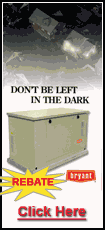|
 Millipedes move in Millipedes move in
By John
Fulton
 Send a link to a friend
Send a link to a friend
[October 15, 2007]
The last week has found the lowly millipede
taking homes by storm. If millipedes were insects, they would
deserve "insect of the week" honors. Since they are not insects,
we'll just dub them "pest of the week."
|
 What are millipedes? They belong to the arthropod class
Diplododa, which means double-footed. The reason is simple: They
have two legs per body segment. There are many different types
of millipedes -- over 1,000 actually. They prefer to live in
moist places, such as under mulch, in flower beds, in
good-quality lawns and under wood. They feed on decaying organic
matter and occasionally on tender leaves or roots. Millipedes
lay eggs in the soil in spring and summer months and usually
overwinter as the adults that we are seeing now. What are millipedes? They belong to the arthropod class
Diplododa, which means double-footed. The reason is simple: They
have two legs per body segment. There are many different types
of millipedes -- over 1,000 actually. They prefer to live in
moist places, such as under mulch, in flower beds, in
good-quality lawns and under wood. They feed on decaying organic
matter and occasionally on tender leaves or roots. Millipedes
lay eggs in the soil in spring and summer months and usually
overwinter as the adults that we are seeing now.The big
problem with millipedes is that they migrate. Right now they may
be migrating through your living room. Nobody knows for sure why
they migrate, but the best guesses involve searching for food
sources and seeking moisture.

Unlike centipedes, millipedes don't bite or sting. They do
give off a bad odor when disturbed or smashed. Be careful
crushing them on carpeting, as they can cause a stain. If you're
not sure whether you have millipedes or centipedes, here are
some differences: Centipedes have one leg per body segment,
while millipedes have two; centipedes normally have much longer
legs than millipedes; and centipedes move rapidly, while
millipedes move slowly.
Now that we know a little about millipedes, how do we get rid
of them? Well, there isn't a simple answer (or I'd be rich), but
an integrated program gives the best results. A program that
uses both chemical and nonchemical methods is usually most
effective.
[to top of second column]
 |

Nonchemical controls aim at removing the moist resting places.
Dethatch your lawn to reduce that damp thatch layer just above the
soil surface; closely mow and edge the lawn to allow it to dry
quickly; remove debris that provides hiding places; pull mulch away
from the house; water grass in the early morning; and keep leaves
from piling up along the foundation. The crumbling leaf material is
an ideal cover and food source for millipedes. Use of glue boards
for mice will also catch an amazing number of millipedes.
If millipedes get inside the house, the vacuum cleaner is
probably the best control. It is nonchemical and prevents stains
from smashed millipedes. Other controls in the home are sticky
boards such as are used for mouse control, aerosol sprays that are
used for flying insects and baseboard spays used for ants.
Outside the house, start with a foundation spray of something
such as propoxur, bifenthrin, permethrin or Sevin. Spray the
foundation and the adjacent foot or so of soil and plants or lawn.
Make sure you treat doorways and other openings as well. Since
millipedes aren't insects to begin with, don't expect a complete
wipeout with a chemical spray program.
[Text from file received from
John
Fulton, University of Illinois Extension,
Logan County Unit]
 |